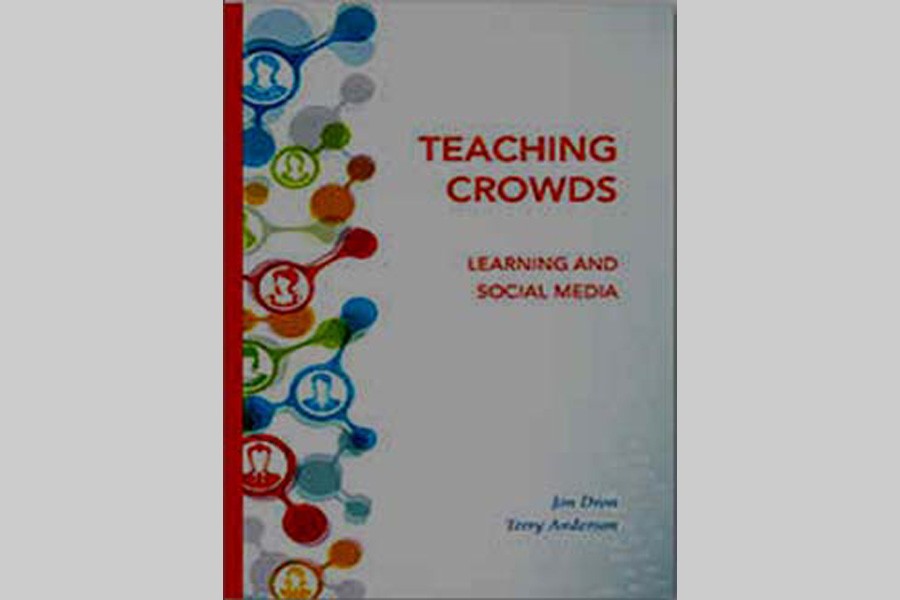Around the world digital technologies as well as social media have revolutionised education. They challenge the traditional approaches of classroom teaching-learning, and the way education is managed. The book Teaching Crowds: Learning and Social Media by Dr. Jon Dron and Terry Anderson of Athabasca University, Canada, attempts to introduce a new model for understanding and exploiting the pedagogical potential of Web-based technologies. Recognising the e-learning / online education as new model of teaching and learning, the authors show how learners can engage with social media platforms to create an unbounded field of emergent connections. These connections empower learners, allowing them to draw from one another's expertise to formulate and fulfil their own educational objectives. In an increasingly interconnected world, developing such skills will, the authors argue, better prepare students to become self-directed, lifelong learners.
In the opening chapter 'On the Nature and Value of Social Software for Learning', the authors provide an overview of social software and present a list of ways that can be used by the learners, describing some of the potentially valuable functions and features that are available in these systems. This chapter is intended to establish a common understanding and vocabulary that provides a background to issues explored in greater depth throughout the rest of the book.
In the second chapter 'Social Learning Theories', the authors present a range of theories-some mature, others still evolving-that have developed in the various phases with social learning technologies over the past few decades. They make considerable use of three-generation model of distance learning pedagogies, describing the shift from early behaviourist and 'cognitivist' models to the era of social constructivism and then on to the emerging `connectivist' age of distance learning. In the chapter 3 'A Typology of Social Forms for Learning', the authors provide a framework for understanding the different ways in which people engage with one another in a learning situation. They introduce the model of social forms, which categorises three broad and overlapping modes of social engagement used for learning: groups, networks (or nets), and sets. Social media have, however, made it considerably easier to engage with people in other ways, notably through social networks and social sets (loose communities defined by a particular interest, or by place, or by some other shared trait).
In chapters 4 to 7, the authors delve into the details of how learning and teaching happens in groups, networks, sets, and collectives. They describe methods, tools, pedagogies, and approaches that are of value in each of these four modalities, as well as their distinguishing features and points of overlaps. In chapter 8 'Stories From the Field', the authors share some of their discoveries as users and developers of social systems for learning. By translating the abstract ideas and models presented in previous chapters into concrete form, this chapter illustrates how the messiness of real-life settings provokes complex, and sometimes unanticipated, responses and evolving, rather than predetermined, outcomes.
In chapter 9 'Issues and Challenges in Educational Uses of Social Software' , the writers accordingly examine the dark side of social software-the ways in which it can undermine or even jeopardise, rather than deepen and extend, the experience of learning. They present a series of over-arching issues that warrant consideration by anyone who plans to use social software for learning. These include issues surrounding privacy, disclosure, and trust, cross-cultural dissonances, problems posed by the complexities of technology and by the digital divide, unpredictable systemic effects, and risks such as mob stupidity and filter bubbles.
In the concluding chapter 'The Shape of Things and of Things to Come', the authors identify current trends in teaching-learning activities, make some tentative predictions about what will happen next, and offer some wild speculations about what might happen if the world were a less complex place and there were fewer constraints on the effects and affordances of social systems on education. They head toward the end of this book with some observations and speculations that probably reveal as much about us and our philosophical stances as they do about the future. It is fair to say that many generations have felt their educational systems were failing them. The authors would like to suggest that there are some significant differences between the current era and earlier times, and that a significant number of them relate to the growth of digital/virtual-space, both in terms of opportunities and threats.
An underlying theme of the book is that learning and teaching involve a complex interplay of technologies, pedagogies, organisational structures, social bonds, and individual needs with many interdependencies and systemic consequences.
The writer is an independent researcher.


